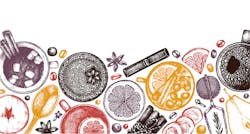Like most things in life, an ideal product mix is never truly finished. New products are continually offered in workplace beverages, incorporating the many trends driving consumer preferences. The number of new beverage options can be daunting, leading operators to wonder how to fit new products and traditional favorites in their warehouses (and in their clients’ break rooms). We asked suppliers to advise operators on the biggest trends impacting beverages in 2020.
1. Consumers want variety and quality
It’s not enough to stock your vending machines, micro markets and office coffee service (OCS) accounts with traditional favorites. In addition to supplying the products and brands consumers know and love, consider integrating a variety of new, high-quality beverages to encourage customers to make repeat visits throughout the workday.
“Consumers are consistently looking for high-quality coffee, teas and specialty drinks such as lattes, cappuccinos and mochas,” said Jason College, vice president of sales at Newco. “Cold brew coffees and nitro — while a smaller percentage of the market — create additional opportunities to enjoy coffees cold and infused throughout the day.”
Melissa Kalimov, COO at RISE Brewing Co., noted that part of a positive retail experience involves introducing consumers to new options and competitors outside the office are already offering these consumers a wider selection of new products.
“People want to have an element of discovery in these experiences,” she said. “With the explosion of new and interesting options for snacks and beverages in the grocery store, people are also looking for their offices and micro markets to be a platform of ‘what’s new’ and brand discovery.”
Additionally, if your clients’ employees don’t see what they want in the break room, they’re more likely to leave the office, causing a decrease in productivity and time spent working. According to a 2019 Technomic Office Coffee Trend Report, 58% of consumers say having a variety of coffee options at work is important to them, and 86% say they at least sometimes purchase coffee off-site over drinking their work-provided coffee.
“Consumers expect the same quality of coffee they enjoy at home when they are at work, which is why we are committed to offering a selection of popular coffee brands through our Away from Home distribution including the recent introduction of 1850® coffee,” said Tim Wayne, vice president and general manager, Away From Home, The J.M. Smucker Company. “We recognize that consumers’ coffee preferences have evolved, and that this is even more diverse in an office setting. We are well positioned to meet these with the variety of brands we offer.”
2. Healthy, better-for-you options remain popular
In October 2019, NAMA announced its Public Health Commitment to increase the percentage of better-for-you offerings in vending machines to 33%, where beverage sales are by far the category leader. Many operators were already recognizing this consumer demand in their own vending, micro market and OCS accounts, and suppliers were more than prepared to join this initiative.
“When NAMA made its Public Health Commitment, PepsiCo vending was already tracking over the industry average in terms of the percent of better-for-you category offerings represented of all brands merchandised,” explained Aziel Rivers, senior director, PepsiCo Foodservice Innovation. “We continue to pursue a journey towards better-for-you offerings with Hello Goodness merchandising and brands created to meet USDA standards.”
Rivers said that PepsiCo’s Hello Goodness platform offers vending and equipment options to conveniently serve up more than 250 better-for-you products, including bestsellers Aquafina, bubly, Pure Leaf Tea, Naked Juice, Tropicana and Starbucks Cold Brew.
"The consumer demand for healthier offerings continues to tick up,” he added. “Our Hello Goodness vending platform was developed in partnership with operators to address the growing demand for better-for-you snack and beverage choices for people on-the-go.”
Ben Gordon, co-founder and president of Wandering Bear Coffee, said that consumer demand for better-for-you products has fully permeated the office setting.
“Offering products with healthy nutritional content and offering a variety of products that may cater to different dieting priorities is now the expectation,” he said. “We make delicious, very strong, organic-certified coffee. It’s bold and smooth, it’s clean label; no sugar in any of our products.”
While health-conscious consumers are reaching for options that align with their dietary needs, better-for-you beverages still have to taste good, or consumers will leave them in the cooler. “I think that consumer awareness brought on by challenges in the healthcare industry make people so much more aware of what goes into their bodies,” said David Smaltz, vice president of vending and foodservice at Celsius.
“The trend continues to be towards items that meet certain criteria: low/no sugar, gluten-free, non GMO, vegan friendly, and no additives or preservatives. Most importantly, it must taste great. Combination flavors seem to be what consumers are demanding; flavors like our Fuji Apple Pear and Kiwi Guava are growing fast.”
3. Coffee that’s fresh, local and sustainable tells a story
Consumers are generally more educated about coffee — third-wave coffee shops have proliferated nationwide and information about coffee is easily accessed online. Operators can effectively reach these educated coffee enthusiasts by offering fresh, local and sustainable coffee products in the workplace — products that tell a story that resonates with consumers.
“The proliferation of specialty coffee in recent years, in terms of both awareness and availability, has created a consumer base that is more informed and more demanding, and this has extended to the office consumption occasion,” explained Gordon. “Consumers, both in and out of the office, have come to expect a certain level of freshness in their coffee.”
Gordon said that this emphasis on freshness helped fuel the rise of bean-to-cup machines in offices. He also said that companies are looking for every opportunity to reduce waste. Suppliers can respond by eliminating single-use packaging and plastics, opting for environmentally-friendly options such as bulk packaging, glass, paper or aluminum. Of course, sustainability is just part of the story that can be shared.
“Consumers want to know about their coffee,” Gordon continued. “Where it came from, what type of roast it is, who roasted it. There’s a certain amount of storytelling, which has long been part of the cafe culture, that we’re seeing have an impact in offices as well.”
Ron Scadina, vice president of sales at Steeped Coffee, said that his company connects office workers to businesses in their communities by working with local roasters, as many consumers (particularly millennials and the emerging Gen Z workforce) are passionate about supporting local companies.
“Consumers want the best coffee, locally roasted. We offer companies the ability to have local roasters in their break rooms,” he said. “We package for over 100 third-wave roasters across North America.”
Scadina said Steeped Coffee’s single-serve packaging is ideal for companies hoping to achieve higher sustainability standards in their break rooms.
“Our single-serve cup of coffee is guilt-free,” he said. “Companies have internal goals to reduce their impact on the environment. Our compostable single-serve fresh ground nitro sealed packs reduce waste and reduce water consumption. They say the sink is the largest consumer of brewed coffee.”
Nitro coffee, cold brew, iced coffee and ready-to-drink [RTD] are increasingly popular in the workplace, particularly among younger employees.
“As Gen Z is entering the workforce, they have set preferences on their coffee and demand for these types of offerings will intensify,” Wayne said.
According to Technomic, Gen Z skews the greatest for iced or cold coffee, with 49% indicating a preference for this format. “Cold brew also continues to trend, and we expect to continue to see more people gravitate toward cold brew and nitro cold brew offerings within the OCS and vending space,” Kalimov added. “I think we’re still in the beginning of the wave of RTD coffee and cold brew. More people are converting each year because it offers something familiar and habitual, but with a new twist and in a more convenient format.”
4. Consumers love coffee and coffee alternatives
Coffee is a necessity in the workplace, but consumers also want non-caffeinated beverages, particularly later in the day. While soft drinks (caffeinated and caffeine-free) are still selling strong, flavored sparkling water continues to grow in popularity.
“The sparkling water category has exploded over the past few years, and there is growing consumer demand for flavored and sparkling water across multiple channels and in different varieties,” Rivers said, noting that PepsiCo’s bubly is the number-one growing sparkling water brand. “Our research found that 75% of sparkling water consumers believe flavor variety is very important. This is a great way to drive purchases from regular water drinkers as bubly contains no artificial flavors, sweeteners or calories, but offers more sweetness than regular water.”
Scadina noted an increased demand in sparkling water in ready-to-drink and point-of-use coolers. “Kombucha and keg teas are becoming very popular,” he said.
Gordon explained that dispensing cold beverages through a tap creates a special, unique experience for consumers, especially in the workplace.“There is real value in elevating the user experience, making an otherwise mundane daily transaction feel just a little bit special,” he said. “For beverage, we’ve seen this achieved through cool dispensing mechanisms: kegerators with cold brew coffee and kombucha on tap, Bevi machines with still or sparkling water at your fingertips, that sort of thing.”
Tea continues to be a strong coffee alternative for consumers in the workplace. According to College, Newco has experienced an increase in tea purchases through OCS over the past year. “As consumers continue to become educated on the health benefits of tea and as a refreshing alternative to coffee, we continue to see more interest,” he said.
Turning challenges into opportunities
Operators in convenience services face unique challenges and are constantly under threat from competitors encroaching into their space. The very nature of a vending machine or micro market — meant to be a convenient, quick stop that efficiently meets a consumer’s need — doesn’t automatically lend itself to a culture of loyalty.
“A sense of loyalty is difficult to develop in such an on-the-go, transactional space,” Rivers said. “The next frontier of marketing in this space should seek to develop a longitudinal relationship with the consumer rooted in the quality of the experience. That may take the form of a digital interaction with the unit or the interface itself.”
While operators can encourage loyalty by offering high-quality products and superior customer service, they’re also limited by space, clients’ budgets, and what types of products are ideal fits for the workplace. Operators who are introducing new products should track the sales of these items to ensure they deserve a spot in the machine or cooler.
“Being aware of unit movement is the most effective and efficient way to grow sales and profits,” Smaltz said. “By monitoring unit-by-unit sales data, product discontinuation decisions can be made, which, in turn, provide additional space for top-selling items [and] space to introduce high-potential new items that will drive incremental sales and gross profit growth.”
At the end (and, technically, the beginning) of the day, consumers of workplace beverages want convenience as much as they want quality, discovery and variety. “In today’s time-starved culture, people highly value convenience, which means quick and easy,” Rivers said. “The vending and micro market channel is well poised to meet this consumer trend."
About the Author

Abby White
Abby White previously served as chief editor for Automatic Merchandiser and VendingMarketWatch.com.
To reach the current editor of Automatic Merchandiser and VendingMarketWatch.com, email [email protected].
